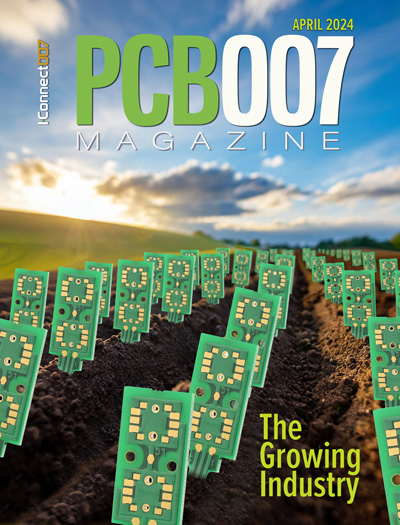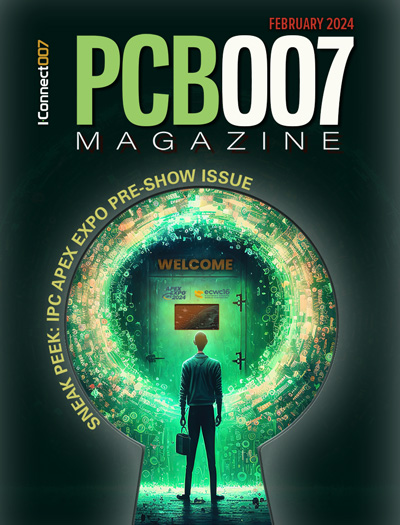-

- News
- Books
Featured Books
- pcb007 Magazine
Latest Issues
Current Issue
The Growing Industry
In this issue of PCB007 Magazine, we talk with leading economic experts, advocacy specialists in Washington, D.C., and PCB company leadership to get a well-rounded picture of what’s happening in the industry today. Don’t miss it.

The Sustainability Issue
Sustainability is one of the most widely used terms in business today, especially for electronics and manufacturing but what does it mean to you? We explore the environmental, business, and economic impacts.

The Fabricator’s Guide to IPC APEX EXPO
This issue previews many of the important events taking place at this year's show and highlights some changes and opportunities. So, buckle up. We are counting down to IPC APEX EXPO 2024.
- Articles
- Columns
Search Console
- Links
- Events
||| MENU - pcb007 Magazine
Happy’s Essential Skills: Computer-Aided-Manufacturing, Part 1—Automation Protocols
September 14, 2016 | Happy HoldenEstimated reading time: 19 minutes
I have addressed automation planning previously in this series, so I hope by now you realize the difference between ‘automation’ and ‘mechanization.’ In printed circuit fabrication and assembly, most of what is advertised is mechanization. But when you get to assembly test, then you begin to see true automated solutions. The difference between the two is the networking and protocols that supply the information and data. An industry for us to look to as an example: our brothers in semiconductor fabrication. This industry has had fully automated factories since the mid-1980s.
INTRODUCTION
This column is dedicated to the automation protocols that currently exist and some new ones just coming on the market. In Part 2, I will present some examples from my own projects.
The ‘messages and recipe data’ needed for production scheduling-to-machine connections has evolved over the years. The selections to be covered here are:
- Serial RS-232C/RS-485
- Parallel IEEE-488/HP-IB
- MAPS™ protocol
- SECS I & SECII/GEM protocols
- OML
- IPC-2541
- LAN (IEEE-802.3 and TCP/IP)
- Wireless and IoT
Recipe-to-Machine and Machine-to-Machine
When I started working with automation control in 1970, we had ASCII characters in parallel cabling. So we started by using these printer and teletype protocols to control machines. Sometimes, we had only BCD to work with! Today you have the ‘lights-out-factory’ and Industry 4.0 initiatives. A lot of progress is the result of the automotive industry’s application of PLCs and robots to manufacturing. Figure 1 shows what the Germans foresee for Industry 4.0[1]. Figure 2 shows the 4-level hierarchy of CAM, while Figure 3 shows typical networked factory control units.
Figure 1: The scope of Industry 4.0 enables an intelligent plant (planet). (Source: Advantech)
Figure 2: Enterprise and plant control topology showing the 4-level hierarchy. (Source: Renesas Edge—Big Data in Manufacturing)
I was fortunate to be employed by Hewlett-Packard. Their 2116-model computers (and later, the 2110) were real-time-interrupt driven computers and ideal for machine control. HP had even developed a CNC machine control system but decided not to sell it since it did not fit their instrument or computer sales force’s experience. They sold all the CNC systems to Allen Bradley in Milwaukee, Wisconsin. Thus, I ended up working frequently with AB to buy back the software that HP had developed. This was serendipitous as AB introduced me to their programmable logic controller (PLC) technology. PLCs became a major tool in machine control.
Figure 3: Typical industrial automation controllers and PLCs. (Source: Wenatchee Valley College, Nevada)
Page 1 of 5
Suggested Items
ZESTRON Academy Launches 2024 Advanced Packaging & Power Electronics Webinar Series
05/01/2024 | ZESTRONZESTRON, the leading global provider of high-precision cleaning products, services, and training solutions in the electronics manufacturing and semiconductor industries, proudly announces the launch of its highly anticipated webinar series on Advanced Packaging & Power Electronics, a webinar series on the latest innovations, cleaning, and corrosion challenges.
The New Industry: Will the Growth Continue?
04/30/2024 | I-Connect007 Editorial TeamHow sustainable are the primary financial models in the United States regarding PCB fabrication shops? In this interview with economic experts Shawn DuBravac and Tom Kastner, we explore what’s happening with U.S. printed circuit board shops in today’s market, how consolidation affects the industry, and what can be done.
TTM’s High Tech Expansion and Industry Innovation
04/30/2024 | Marcy LaRont, PCB007 MagazineTom Edman has been the CEO of TTM Technologies since 2014 and has an extensive background in electronics and manufacturing. TTM is a leading global manufacturer of technology solutions, including mission systems, RF component and RF microwave microelectronics assemblies, and quick turn and advanced technology printed circuit boards.
U.S. Companies Invest Heavily in Robots
04/30/2024 | IFRManufacturing companies in the United States have invested heavily in more automation: total installations of industrial robots rose by 12% and reached 44,303 units in 2023. Number one adopter is the car industry followed by the electrical and electronics sector.
USPAE to Springboard U.S. Technology Forward
04/30/2024 | Marcy LaRont, PCB007 MagazineThe U.S. Partnership for Assured Electronics (USPAE) was launched as a nonprofit subsidiary of IPC in 2020, specifically to manage the DoD relationship and access to funding, and to develop a cooperative facility to develop UHDI capabilities in the U.S., not only for the defense sector, but for the whole of the U.S. electronics industry. It is a tall order, but industry veteran Joe O'Neil believes it will happen. Having been tasked with making the UHDI Capable Cooperative Production Facility (UCCPF) a reality, he provides an update on this important project for U.S. electronics manufacturing.


